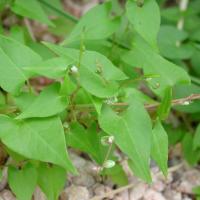Black bindweed
Fallopia convolvulus
Fallopia convolvulus, commonly known as Black-bindweed, is an annual vining weed that can be found in various habitats, including agricultural fields, gardens, and disturbed areas. Let's delve into the details of this weed:
Detailed Appearance:
Black-bindweed is characterized by its twining, slender stems that can reach lengths of up to 2 meters. The leaves are arrowhead-shaped with a pointed tip, and the plant produces inconspicuous greenish-white flowers. The small, dark, triangular seeds are enclosed in a papery sheath.
Key Characters:
One of the key characteristics of Fallopia convolvulus is its vining habit, with stems that wrap around nearby vegetation for support. The arrowhead-shaped leaves and inconspicuous flowers are additional identifying features. The seeds are enclosed in a persistent papery sheath.
Physiology:
As an annual plant, Black-bindweed completes its life cycle within a single growing season. It reproduces by seed, and the twining stems enable it to climb and compete with other plants for sunlight. The plant's physiological adaptations contribute to its ability to colonize diverse environments.
Population Dynamics:
Black-bindweed can form dense populations, especially in cultivated fields and disturbed areas. Its ability to produce numerous seeds contributes to its population dynamics, and the vining habit allows it to outcompete other plants for space and resources.
Dispersal:
The primary mode of dispersal for Fallopia convolvulus is through its seeds. The seeds are dispersed by wind, water, animals, and human activities. The papery sheath around the seeds aids in their dispersal and can facilitate their attachment to clothing or equipment.
Habitat Preferences:
Black-bindweed is adaptable to a range of habitats, including agricultural fields, gardens, waste areas, and roadsides. It thrives in well-drained soils and is often associated with disturbed or cultivated areas.
Growth Cycle:
Being an annual plant, Black-bindweed germinates from seeds in the spring, grows vigorously during the summer, and produces seeds in late summer or early fall. The plant then dies off, and the seeds remain dormant until the following growing season.
Ecological Impact:
While Black-bindweed may have ecological benefits in stabilizing disturbed soils, its aggressive growth can negatively impact crop yields in agricultural settings. Its ability to form dense stands and outcompete crops makes it a challenging weed to manage.
Control Measures:
Effective control of Fallopia convolvulus involves a combination of cultural, mechanical, and chemical methods. Practices such as crop rotation, proper tillage, and early weed detection can help manage populations. Herbicides may be employed, especially in agricultural settings, to control the weed's growth.
Human Interaction:
Black-bindweed often interacts with human activities in agricultural landscapes and disturbed areas. Its competitive nature and rapid growth make it a concern for farmers, necessitating effective control measures to prevent yield losses.













Plant Protection Products
- ⭑⭑⭑
- ⭑⭑⭑
- ⭑⭑⭑
- ⭑⭑⭑
- ⭑⭑⭑
- ⭑⭑⭑
- ⭑⭑⭑
- ⭑⭑⭑
- ⭑⭑⭑
- ⭑⭑⭑
- ⭑⭑⭑
- ⭑⭑⭑
- ⭑⭑⭑
- ⭑⭑⭑
- ⭑⭑⭑
- ⭑⭑⭑
- ⭑⭑⭑
- ⭑⭑⭑
- ⭑⭑⭑
- ⭑⭑⭑
- ⭑⭑⭑
- ⭑⭑⭑
- ⭑⭑⭑
- ⭑⭑⭑
- ⭑⭑⭑
- ⭑⭑⭑
- N/A
- N/A
- ⭑⭑⭑
- N/A
- ⭑⭑⭑
- N/A
- ⭑⭑⭑
- ⭑⭑
- ⭑⭑⭑
- N/A
- N/A
- N/A
- N/A
- N/A
- N/A
- N/A
- N/A
- N/A
- N/A
- N/A
- N/A
- N/A
- N/A
- N/A
- N/A
- N/A
- N/A
- N/A
- N/A
- N/A
- ⭑⭑⭑
- N/A
- N/A
- N/A
- N/A
- N/A
- ⭑⭑⭑
- ⭑⭑⭑
- ⭑⭑⭑
- ⭑⭑⭑
- ⭑⭑⭑
- ⭑⭑⭑
- N/A
- N/A
- N/A
- N/A
- N/A
- N/A
- N/A
- N/A
- N/A
- N/A
- N/A
- N/A
- N/A
- ⭑⭑⭑
- N/A
- N/A
- N/A
- N/A
- N/A
- N/A
- N/A
- N/A
- N/A
- N/A
- N/A
- N/A
- N/A
- N/A
- N/A
- N/A
- N/A
- N/A
- N/A
- N/A
- N/A
- N/A
- N/A
- N/A
- N/A
- N/A
- N/A
- N/A
- N/A
- N/A
- N/A
- N/A
- N/A
- N/A
- N/A
- N/A
- N/A
- N/A
- N/A
- N/A
- N/A
- N/A
- N/A
- N/A
- N/A
- N/A
- N/A
- N/A
- N/A
- N/A
- N/A
- N/A
- N/A
- N/A
- N/A
- N/A
- N/A
- N/A
- N/A
- N/A
- N/A
- N/A
- N/A
- N/A
- N/A
- N/A
- N/A
- N/A
- N/A
- N/A
- N/A
- N/A
- N/A
- N/A
- N/A
- N/A
- N/A
- N/A
- N/A
- N/A
- N/A
- N/A
- N/A
- N/A
- N/A
- N/A
- N/A
- N/A
- N/A